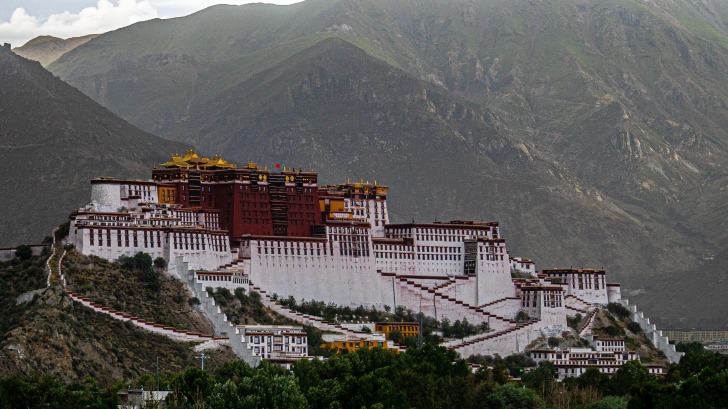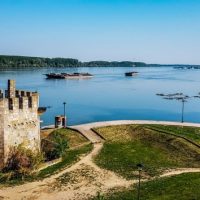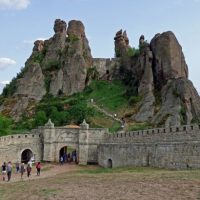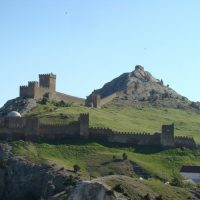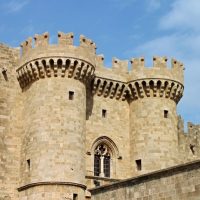Castles in China are often referred to as palaces, based on the Chinese character “gong.”
The country is rich with history dating back thousands of years, so there are many architectural types on display within the castles in major cities and in the countryside.
While some castles are in ruins, others have been beautifully restored.
13 Most Beautiful Castles in China
Whether the castle is a castle, a palace, or a fortress, there are stunning buildings throughout China that are worth exploring for their history, their beauty, and their attention to detail.
Potala Palace
Potala Palace is located in Lhasa and sits on top of a hill for all to see.
The massive complex includes not only the palace but also a monastery and a prison.
It was designed to merge secular and religious power in Tibet.
It is one of the most notable landmarks of the city and was even featured in the movie, The Last Emperor.
It was built by King Songsten Gampo in the 17th century and covers over 360,000 square meters.
Depending on who you talk to, the palace is also referred to as the Puppet Emperor’s Palace because it was here Henry Puyi ruled from, the last puppet ruler of Manchukuo, which was controlled by the Japanese.
Shenyang Imperial Palace
Shenyang Imperial Palace is 1/12 the size of the Forbidden City.
It is a beautiful example of Tibet and Manchurian architecture.
The palace once went by the Mukden Imperial Palace during the Qing dynasty.
The construction began in 1637 and became the residence of the emperor in 1644.
An expansion of the castle was made in 1780 by the Qianlong Emperor.
Today, there are many structures that are preserved and approximately 300 rooms feature exhibits of art and cultural relics.
In 2004, it was entered into UNESCO World Heritage.
Sea Dragon Castle
Hailongtun Castle translates to “sea dragon.”
The fortress may be in ruins, but it still shows that there are well-preserved medieval castles located in China.
It is found on the Longyan Mountain and served as the stronghold of the Bozhou Tusi.
The Ming dynasty destroyed the castle during the Bozhou rebellion.
The history of the castle dates back to 1257 during the Southern Song dynasty.
It is surrounded by cliffs from every direction, and it can only be accessed from a single mountain road.
There are archer’s towers on either die of the gates and a deep moat surrounding them.
It is possible to wander the ruins and a tram will take you up from the visitor’s center.
Diaoyu Fortress
The Diaoyu Fortress is found on the mountain of the same name in Chongqing, China.
It dates back to the 13th century and is on a hill that is surrounded by water on three sides.
On the site, there is the gate, a military camp, a water army wharf, as well as the palace.
The fort even has built-in cannons.
As a result of the historical information that has been preserved, it was placed on the World Cultural Heritage Tentative List.
The fortress is predominantly in ruins, but there are placards around the area that talks about the culture and history, including poems and reliefs.
While in the area, it is also worth exploring Diao Yu Cheng, a historic fishing town.
Baimaguan Fort
The Baimaguan Fort was built during the years 1402 to 1424, during the period of the Yongle emperor of the Ming Dynasty.
The fort is found in the village of Fanzipai and is near the Great Wall of China.
When the fort was active, it supported a defensive line for the northern front of China.
There are hundreds of guard and beacon towers.
Beyond the south gate, most of the property is in ruins.
However, it is still possible to see just how grand of a structure it must have been over 800 years ago.
Gyantse Dzong Castle
The Gyantse Dzong castle is built into the cliffs and, while in ruins, has an interesting story behind it.
The legend is that it was supposed to be a replica of the Potala Palace.
However, when the architect was sent to get the designs, he painted them on radish.
Once he returned, the radish had dried up. As such, the design is built smaller and in a fragmented version.
The architecture can be seen from the town below as well as the Palcho Monastery.
The interior of the location is in ruins and is not open to the public.
Tuancheng Fortress
The Tuancheng Fortress translates to mean “Round wall.”
It was built in 1749 and is a beautiful example of 18th-century Chinese architecture.
It can be found near the Fragrant Hills of Beijing’s Haidian District.
There was a significant amount of prosperity at this time, which is why there are so many ornate details.
It also marks an important part of history since it was built in the last imperial dynasty of China.
The fortress was built in the 14th year of the Qianlong emperor’s reign.
It was built as a military compound so that the Qing could train, inspect, and honor its military troops.
It is possible to visit a significant amount of the fortress through the south city gate tower.
Miran Fort
The Miran Fort was constructed in the 8th century and was active through the 9th century during the Tibetan Empire.
Located in Miran, Xinjiang, it is now a ruined structure.
However, when it was excavated in the early 1900s by archaeologist Aurel Stein, it resulted in finding hundreds of military documents, which are now considered to be some of the oldest documents to have survived the Tibetan Empire.
Today, it is possible to view what is left of the ruined structures – 3 temples, 2 beacons, 8 stupas, as well as tombs, a kiln, and a smelting area.
Wanping Castle
Wanping Castle is a fortress that dates back to the Ming Dynasty and is located in Beijing.
It is known as a walled city and was built between 1638 and 1640.
It was designed to defend the city against Li Zicheng and the uprising of the peasants.
There are two gates to the fortress.
The east gate is known as the “Ever Prosperous Gate” (and has also been renamed to the Majestic Gate.
The west gate is known as the “Favorably Govern Gate.”
Within the fortress walls, you will now find a park, numerous sculptures, and the Museum of the War of Chinese People’s Resistance Against Japanese Aggression.
Weiyuan Fort
Located in Humen, Weiyuan Fort was built in 1835 as a coastal defense.
It was used predominantly throughout the Opium Wars.
It is located under the Humen Bridge in Guangdong.
At one point, there were 44 cannons stationed at the fort to defend against the British.
While it’s not a traditional castle, it is a beautiful building in its own right, especially as it is on both land and sea.
Today, you can visit the Opium Wars Museum on its site.
Xiuying Fort
The Xiuying Fort shows a perfect example of the xieshan roof style, which is the curved roof style that is prevalent throughout much of Chinese architecture.
It was believed that this design would ward off evil spirits.
It is found in Haikou City and was built in 1890.
The Qing government constructed the fort so that it would counter the threat coming from France and was used as a defense in the French invasion that occurred in 1890.
The fort consisted of five towers and build a line in order to have a view of the sea to the north while also creating a line from East to West.
The last time the fort was actively used was to defend against the Japanese in the Cole Attack of 1932.
Tashkurgan Fortress
The Tashkurgan Fortress is also known as the Princess Castle.
It is found on the historical Silk Road and is found in the far northwestern part of China.
The town’s name means “Stone Fortress” and there are a lot of local legends about the castle.
The castle dates back to the Yuan dynasty, which began in 1279.
It is situated at a high altitude and the mountains around it are even higher.
The castle is in ruins today as it is believed that it was destroyed by the Mongols.
Utopia
Utopia is the name that was given to a private residence that was built to look like a castle.
It sits on a private island on the lake of Dushu, located in Suzhou.
The home, which cost approximately $154 million (or 1 billion Chinese yuan) features 32 bedrooms and bathrooms, a mist-covered pond, a swimming pool, and a wine cellar.
The home was christened “Taohuayuan” which translates to “utopia.”
The home took three years to build and consists of 72,000 square feet.
The Xiangshanbang Traditional Architectural and Building Skills handcrafted the brickwork that went into building the castle.
China Safety Overview
READ THE FULL REPORT: China Safety Review
Safety Index: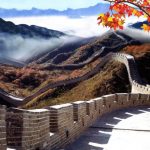
- OVERALL RISK: MEDIUM
- TRANSPORT & TAXIS RISK: LOW
- PICKPOCKETS RISK: MEDIUM
- NATURAL DISASTERS RISK: MEDIUM
- MUGGING RISK: LOW
- TERRORISM RISK: MEDIUM
- SCAMS RISK: MEDIUM
- WOMEN TRAVELERS RISK: MEDIUM
Frequently Asked Questions
What is considered to be the most popular castle in China?
The Shenyang Imperial Palace, which is approximately 600 km from Beijing, receives millions of visitors every year.
What is the oldest palace?
The oldest palace that you can visit is the Shenyang Imperial Palace. However, in 2019, a Shuanghuaishu site was uncovered by archaeologists, located within the Henan Province.
This shows that the Chinese have been constructing palaces for 1,000 years before.
This shows that the Chinese civilization is over 5,000 years old, too.
What well-preserved castles can be toured?
Tuancheng Fortress is a popular castle that has been well-preserved and offers tours where you can see such historic materials as battle axes, gongs, fans, and imperial couches.
It costs 40 RMB to enter the round-walled fort.
Is it possible to visit the Forbidden City?
Despite the name, you can visit the Forbidden City and the castle that is located there.
Entry is only possible through the south gate and admission is restricted to 80,000 visitors per day, so it’s important to buy an advanced ticket.
Where is the presidential palace?
The presidential palace, which is the home of Xi Jinping, is located in Nanjing, Jiangsu, China.
